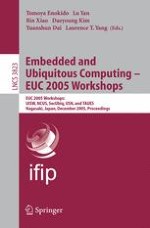2005 | Buch
Embedded and Ubiquitous Computing – EUC 2005 Workshops
EUC 2005 Workshops: UISW, NCUS, SecUbiq, USN, and TAUES, Nagasaki, Japan, December 6-9, 2005. Proceedings
herausgegeben von: Tomoya Enokido, Lu Yan, Bin Xiao, Daeyoung Kim, Yuanshun Dai, Laurence T. Yang
Verlag: Springer Berlin Heidelberg
Buchreihe : Lecture Notes in Computer Science
